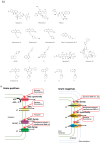Strategies to Overcome Antimicrobial Resistance (AMR) Making Use of Non-Essential Target Inhibitors: A Review
- PMID: 31766441
- PMCID: PMC6928725
- DOI: 10.3390/ijms20235844
Strategies to Overcome Antimicrobial Resistance (AMR) Making Use of Non-Essential Target Inhibitors: A Review
Abstract
Antibiotics have always been considered as one of the most relevant discoveries of the twentieth century. Unfortunately, the dawn of the antibiotic era has sadly corresponded to the rise of the phenomenon of antimicrobial resistance (AMR), which is a natural process whereby microbes evolve in such a way to withstand the action of drugs. In this context, the identification of new potential antimicrobial targets and/or the identification of new chemical entities as antimicrobial drugs are in great demand. To date, among the many possible approaches used to deal with antibiotic resistance is the use of antibiotic adjuvants that hit bacterial non-essential targets. In this review, the author focuses on the discovery of antibiotic adjuvants and on new tools to study and reduce the prevalence of resistant bacterial infections.
Keywords: Antibiotic resistance; antibiotic adjuvant therapies; beta-lactamases inhibitors; combination therapy; efflux pump inhibitors; membrane permeabilizers; non-essential targets; virulence factors.
Conflict of interest statement
The authors declare no conflict of interest.
Figures








References
Publication types
MeSH terms
Substances
LinkOut - more resources
Full Text Sources
Medical

